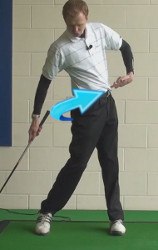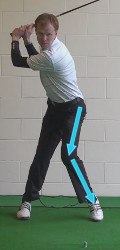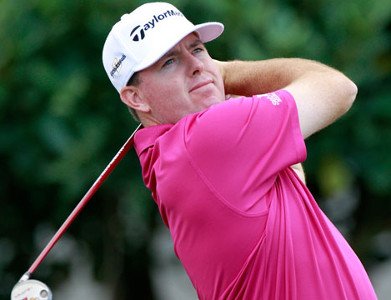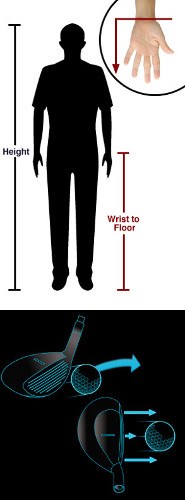
He's listed by the PGA Tour at 5'11” and 190 pounds, but Robert Garrigus looks bigger than that. He certainly plays bigger.
The veteran pro has ranked among the Tour's top four in driving distance every year since 2006, leading the standings in 2009 – when averaged a prodigious 315.5 yards per drive -- and again in 2010.
The rest of Garrigus' game is aging nicely, too. At 34 years old, he's enjoyed his best season yet in 2012, ranking 25th on the money list heading into the Tour Championship. While his lone victory came at the 2010 Children's Miracle Network Classic, he's knocked on the door often, with three runner-up finishes in 2012.
Let's take a look at how Garrigus generates such outrageous distance off the tee.
Garrigus' signature: Massive body rotation on the downswing and through the shot.

Who else does it: Dustin Johnson, Gary Woodland
Unlike most big hitters, Garrigus does not take the club to a parallel position at the top. His wrists are held firm, with the clubface slightly closed relative to the target line. From there, though, his power is really unleashed.
On the downswing, Garrigus works his left hip and knee furiously toward the target, with the right side following in tow. His upper body unwinds with such force that Garrigus' head turns with it; less than halfway down, his eyes point to a spot well in front of the ball – highly unusual for a pro.
Reaching impact, Garrigus' hips face well left of the target – again, farther than most pros' – while his left leg begins to straighten Meanwhile, his right side continues turning and he explodes upward, into the ball. A number of bombers share this move, including Tiger Woods and Rory McIlroy.
Garrigus' right heel rises noticeably off the ground as the club approaches impact, and he's up on his right toe at the finish. However, he exhibits much “quieter” feet when hitting iron shots, which require more control.

Why it works for Garrigus: Except for the length of his backswing, everything about Garrigus screams “power hitter,” starting with his strong grip position. He pairs a full shoulder turn with a somewhat restricted hip rotation, creating what teacher Jim McLean dubs a large “X-Factor” – the difference between the degree of upper and lower body rotation. Like many of his big-hitting peers, Garrigus achieves great width by extending his hands far from his head as he reaches the top.
Like Johnson, Garrigus must compensate on the downswing for his closed clubface position at the top. His tremendous lower body rotation causes the clubhead to lag ever so slightly, preventing it from closing at impact. Otherwise, he'd hit massive hooks.
How it can work for you: Regardless of your size, you'll never maximize your power without properly rotating the hips and shoulders. Most importantly, the downswing must follow the correct sequence.
If you've managed to make a full shoulder and hip turn going back, you're halfway there. That good work can come unraveled, though, if you start down with the hands and arms. Instead, the left heel initiates the downswing by pressing into the ground. This touches off a chain reaction in which the hips, torso and shoulders act in unison to pull the arms and club downward into the ball.
Watch this video tip to learn How to Trigger the Downswing.

Robert Garrigus Massive Rotation Equals Monster Drives
By any measure, Robert Garrigus is one of the longest drivers on the PGA Tour. If you look at average driving distance, Garrigus finished 18th on Tour for the 2016 season with an average drive of over 303 yards. Or, if you prefer to look at swing speed, Garrigus impressed there too – with an average club head speed of 116.9 miles per hour, good for 37th on Tour. While there is certainly more to this game than just smashing long drives, it does help to be a long hitter when trying to compete with the best players in the world. For Garrigus, the long ball is not a problem, as he uses great body rotation to unleash a powerful blow into the ball time after time.
Some of the golfers you will see blasting massive drives on the PGA Tour are blessed with impressive size that helps them to create such power. Often, the long hitters are those who stand 6'2'' or taller, as they can use the leverage from their long arms to develop speed. Dustin Johnson is a great example of this kind of player. That is not the case with Garrigus, however, who stands just 5'11'' and weighs in around 175 pounds. Without overwhelming size on his side, Garrigus relies on great technique and a huge shoulder turn to generate his speed.
While he may not be a household name, Garrigus has certainly turned his long-driving ability into a long-lasting career. First turning professional back in 1997, the 39-year-old Garrigus has bounced around between tours along the way. The highlight of his professional career came at the 2010 Children's Miracle Network Classic, which he won (for his only Tour victory to date). Garrigus has also posted a top-ten finish in a major, that coming in the form of a T3 at the 2011 U.S. Open. In all, Garrigus has competed in 11 majors during his career, making the cut four times.
In this article, we are going to take a closer look at the golf swing of Robert Garrigus. Specifically, we are going to look at his swing in an effort to find tips which can help you in your own game. It is always a good idea to look at the golf swings of professional golfers for inspiration as you try to move your game in the right direction. You certainly don't want to attempt to copy any one specific swing frame for frame, but you can learn small things that just may apply nicely to the swing you already have in place. As you read through the content below about the swing that Garrigus uses to compete with the best in the world, think about your own game and how his technique might be able to influence how you play.
All of the instruction included below is based on a right handed golfer. If you happen to play left handed, please take a moment to reverse the directions as necessary.

A Great Shoulder Turn
As you could probably guess from the title of this article, it is the shoulder turn that Robert Garrigus uses in his swing which is going to first draw your attention. Like almost every other long hitter in the game, Garrigus rotates his shoulders tremendously in the backswing – giving him plenty of time and space to accelerate the club in the downswing. In this way, Garrigus plays like someone who is much taller than 5'11''. Thanks to his great shoulder turn, the club has ample time to speed up on the way down, giving him an advantage over a player who makes a shorter turn. You probably already knew that a big shoulder turn was one of the keys to power in the golf swing, but watching a swing video of Robert Garrigus hitting a driver is only going to drive that point home.
So why aren't most amateur golfers able to make a turn that can compare to what Garrigus uses in his swing? The following three mistakes are common in the amateur game, and each has the potential to rob you of shoulder rotation.
- Rushing the backswing. This is a problem that plagues many amateur golfers, yet there is rarely a sign of it in the professional game. When you watch Garrigus' swing, for instance, you see that he takes plenty of time to get up to the top of the swing. His backswing isn't slow, per se, but it definitely isn't rushed. By taking his time, Garrigus is able to make it all the way up to the top without robbing himself of valuable distance in the turn. Those last few inches of rotation can make a big difference in terms of the speed you can generate in your swing, but you will never get to finish your turn if you are in too much of a hurry to start the downswing. Take your time, let the club get all the way up to the top, and only start down when you are ready to give it all you've got.
- Flexibility. It takes flexibility to be able to rotate back to where your left shoulder is behind the ball at the top of the swing. You don't necessarily have to be in top physical condition to play good golf, but it does help to at least maintain a reasonable level of fitness. Consider working with a trainer who can help you complete some golf-specific exercises in order to achieve greater flexibility during your swing. Of course, you should always check with a doctor before beginning any kind of workout program.
- Poor setup. One of the overlooked elements of shoulder rotation is actually your setup position. If you set up in a poor position, it will be difficult – or even impossible – to fully turn your shoulders away from the target. Elements of a good setup include flex in your knees, shoulders and hips that are square to the line, a chin that is up away from your chest, and more. Be sure to spend some time working on building a quality setup position before you move on to working on your shoulder rotation. After all, you really can't have one without the other.
Any one of the points on the list above has the ability to harm your shoulder rotation. As you work on your swing on the driving range, pay attention to each of these points specifically to confirm that you are on the right track. When you do manage to unlock an improved shoulder turn, you will likely be surprised to find just how much extra power is waiting to be used.

Turning It Loose
There is a lot to be said for quality swing mechanics when looking for the longest possible drives from the tee. It isn't good enough just to swing hard and hope for the best – you have to use the right techniques in order to maximize the acceleration of the club into the back of the ball. However, with that said, the mindset that you have as you stand over the ball plays a role in the length of your drives as well. You can be sure that Robert Garrigus is fully committed to turning the club loose when he takes his driver from the bag, and you need to be thinking in much the same way.
Sadly, many amateur golfers stand on the tee with fear in the back of their minds when holding the driver. Instead of thinking about sending the ball a great distance down the middle of the fairway, these players are worried about hitting the ball into the water, into a bunker, into the trees, or anywhere else but the short grass. When you have that kind of mindset as you prepare to hit a drive, there is no chance that you are going to unleash all of your potential power into the ball. To be a power player, you have to turn that mindset around and focus only on the positive as you prepare to swing. By imaging the ball flying high down the middle of the fairway, you can give yourself the confidence and belief you need to turn your big shoulder turn into a great overall swing.
If you would like to improve on the mindset that you use while hitting tee shots, check out the three tips listed below -
- Pick a specific target. One of the best ways to get rid of the fear that may be in the back of your mind about a given tee shot is to pick out a very specific target in the fairway. Most golfers just aim 'for the middle of the fairway', but you can do a little bit better than that. Select a specific target such as a tree in the distance or a dark patch of grass and use that spot to guide your swing. As long as you are focused in on hitting that spot, you won't have time to worry about being nervous. Professional golfers are great at picking spots for every shot that they hit, and you should make it a goal to do the same.
- Take the time to warm up. Nothing will build your confidence in the driver quite like hitting a handful of great shots on the range prior to starting your round. Do your best to arrive at the course with plenty of time to warm up, and hit at least a small bucket of balls using a number of different clubs. Working your way through your way in a thorough warm up session will not only get you loose, but it will serve your confidence as well. Specifically, hit several driver shots in a row and use those swings to put yourself in a positive frame of mind once out on the course.
- Have fun. It is always important to remember that golf is just a game, and you should be having fun at all times on the course. There isn't much you get to do on the course that is quite as fun as blasting away at your driver, so you should really be enjoying yourself when hitting these shots. Are you going to hit a bad one from time to time? Sure – everybody does. That doesn't mean you can't still enjoy the process of hitting long drives, however. Focus in on your target, pay attention to your fundamentals, swing hard, and look forward to seeing the ball soar high down the middle of the fairway.
You are never going to live up to your distance potential if you are constantly holding something back on the tee. While you don't necessarily need to swing flat out at every single tee shot, you do want to have the mindset to turn it loose when you have a sufficient target in front of you. Robert Garrigus is certainly turning it loose when he steps on the tee – you can't average over 300 yards a drive by holding back – and he's playing in the biggest golf tournaments in the world. If he can turn it loose on the PGA Tour, you can certainly let it go when playing the average weekend game with your friends.

Other Fundamentals
Making a great turn is certainly a big part of hitting long drives, but it is far from the only fundamental that you need to have in place. If you take a moment to review a video of Robert Garrigus' swing, you will see that he does plenty of other things well in addition to making that big shoulder turn. To go along with his rotation, Garrigus also hits on all of the points on the following list -
- Great extension going back. One of the first things you are going to notice about the golf swing of Robert Garrigus is just how much extension he gets during the early stages of the backswing. In fact, you could argue that this part of his technique is even more notable than the overall rotation of his shoulders. When the club reaches parallel with the ground on the way back, Garrigus has his left arm fully extended and there is only a slight amount of bend in his right arm. It is this width that sets the stage for a great shoulder turn, and it also allows him to create an incredibly long swing arc despite not being among the tallest players on Tour. Most amateur golfers struggle to get much in the way of extension during the backswing, so this is a point that could help almost all golfers produce more power.
- Stable head position. You can watch Garrigus' swing from start to finish and you aren't going to see his head move much at any point. Yes, it is going to turn slightly toward the target during the downswing, which is fine, but it will not be moving up or down dramatically. The typical golf moves his or her head all around during the swing, but that is just not the case with Garrigus. Thanks to this stability, he is able to swing extremely hard without losing track of the path he needs to take back into the ball. In the end, he is left with a swing which is both powerful and controlled – and that is an extremely valuable combination.
- Staying back through impact. Another notable characteristic of this golf swing is the way Garrigus manages to stay back through impact while rotating quickly toward the target. Many golfers allow themselves to get pulled onto their left leg during the follow through, but there is no hint of that mistake when you watch Garrigus hit tee shots. Instead, he stays back beautifully, making it possible to unload all of his power directly into the back of the ball. During your next practice session, make it a point to stay back as you swing through impact – you just might be surprised at the results.
- A balanced finish. You get the feeling that Robert Garrigus could hold his finish position all day, if he wanted to. How is he able to arrive at such a balanced finish after swinging the club in excess of 115 miles per hour? Simple – he has maintained his fundamentals and mechanics all along the way. A fast golf swing doesn't have to be one that is out of control, and Garrigus walks that line perfectly. Thanks to the excellent fundamentals that he uses, such as great extension, a big turn, and a stable head, it is easy for him to remain balanced after unleashing his swing through impact. While you may never be able to swing the club with quite as much authority as Garrigus, there is no reason why you can wind up in the same type of balanced, controlled finish.
You don't get to the highest level of the game without having a solid all-around golf swing. Yes, Garrigus is able to launch the ball a long distance from the tee, but he has to control that ball in order to post good scores on extremely difficult courses. As you can see from all of the positive elements that are included in his swing, Garrigus is able to mash long drives while still remaining in control of his swinging action at all times.

The Equipment Factor
When Robert Garrigus prepares to play an event on the PGA Tour, he has nearly endless equipment options at his disposal. He can have his clubs customized in any of a number of ways to make sure that he is getting the most from his swing. While the clubs will never actually do the work of hitting shots, there is no doubt that having the right clubs in your hands can make a big difference.
On this point, you should be paying attention to your own equipment to make sure you are using the right gear. You aren't going to have a Tour equipment van following you around to each course that you play, but you can lean on some modern technology to pick out a driver which is a great fit for your swing. Consider heading to a local course for a club fitting session that will measure your swing in a number of ways. Once the club fitter has measurements of your swing, he or she will be able to offer up suggestions for both club heads and shafts that you may want to consider. In the end, you should come away with a driver that is well-suited to your swing, and one that will allow you to play your best on a consistent basis.
In addition to making sure that you have the right driver in your hands, you should also check to make sure you are using the right golf ball. The ball that you choose is going to say a lot about how far you are able to hit your drives. With the right ball, you can get an optimal flight which will sail down the fairway on a high but flat trajectory. The wrong ball, unfortunately, can have the opposite effect. With a ball that spins too much, your drives will climb high and fall down short of where they could have reached with a better golf ball. Or, if you use a ball that spins too little for your game, your shots will stay very low to the ground and will need firm fairways and plenty of roll to reach a good distance. Take some time to confirm that you have both the right driver and right golf ball to make sure you aren't wasting great swings on the wrong equipment.
It is unlikely that you ever are able to drive the golf ball with the kind of power and control that is exhibited by Robert Garrigus. However, with practice and attention to detail, you certainly can improve on your current level of play. Use the tips highlighted in this article to guide your practice, and look forward to hitting some of the best drives of your life in the very near future.






